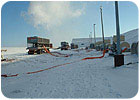
Despite the snow in this picture, company officials at this sugar beet processing facility faced a warm spring in 2007 and worried their large crop would thaw and spoil before it could be processed. Rental chillers and ice mats kept the sugar beets frozen until they were ready for processing.
Spring 2007 was warmer than usual in Minnesota’s Red River Valley, putting millions of dollars of sugar beets at risk. So American Crystal Sugar Company (ACSC), an agricultural cooperative headquartered in Moorhead, MN, had to find a cool solution fast.
American Crystal Sugar Company grows and processes sugar beets in the Red River Valley, which crosses the border of northwestern Minnesota and eastern North Dakota. The company is the largest sugar beet producer in the U.S., refining about 15% of America’s sugar with a workforce of 1,700 full- and part-time employees.
Typically, the sugar beets are harvested each fall and placed in piles outdoors. The piles are massive - 880 ft long by 225 ft wide and 32 ft high. Each pile is worth approximately $5 million. Sub-freezing temperatures are critical to preserving the quality of the harvested sugar beets. The piles generally stay frozen through early March, but start to thaw as temperatures increase. The factories operate from September through May.
But faced with a warm spring in 2007, company officials worried their large crop would thaw and spoil before they could be processed. They knew the larger the loss, the greater the cost to the bottom line.
A Lot To Lose
“We needed an economical way to stop the crop from thawing,” said Dan Bernhardson, director of agriculture for ACSC. “We wanted an alternative to constructing a building to store the crop. We currently have 12 large buildings where we store between 50,000-75,000 tons of sugar beets in each of the buildings; they’re very big buildings and capital cost is extremely high. So, we were looking for a way to manage a large crop and keep it in storage and have time to process them before they deteriorated.”The year before, ACSC had conducted a test project, using rented chillers and an ice mat to keep the huge piles of sugar beets frozen through late April. It worked.
For 2007, the company sought a similar solution. “We looked at Trane and the company we had utilized previously for rental chillers,” Bernhardson explained. “It’s our company’s process for projects of that size to go out for competitive bids, and Trane was a successful bidder.”
The company called on Trane Rental Services, which provide temporary HVAC solutions with its fleet of rental air and water cooled chillers, air conditioners, generators and accessories. The equipment is always prepped and ready to ship from stock located in major cities across North America. The chillers have capacities from a one-half ton portable cooler to thousands of tons of chilled water.
Trane and Ice Rink Events together created a solution. Borrowing from ice arena technology, the sugar beets were covered with ice mats from CALMAC. Ten-degree Fahrenheit glycol solution was pumped into the mats, generated by nearly a dozen 200- and 300-ton Trane air cooled chillers. This kept the sugar beets frozen until they were ready for processing.
Beeting The Weather
Thanks to the rental chillers, American Crystal Sugar Company saved approximately $1 million worth of sugar beets during the 2007 season. Another benefit: ACSC got the exact amount of cooling capacity it required and didn’t spend capital on permanent facilities and equipment.This year ACSC will again use Trane’s outdoor chiller technology to avoid building a new storage facility and to be sure its sugar beets stay frozen long enough to be processed. “Last year was a success,” Bernhardson said. “As we move forward into 2008, we are happy to say we worked with Trane to identify how to make the process even more successful.” ES
